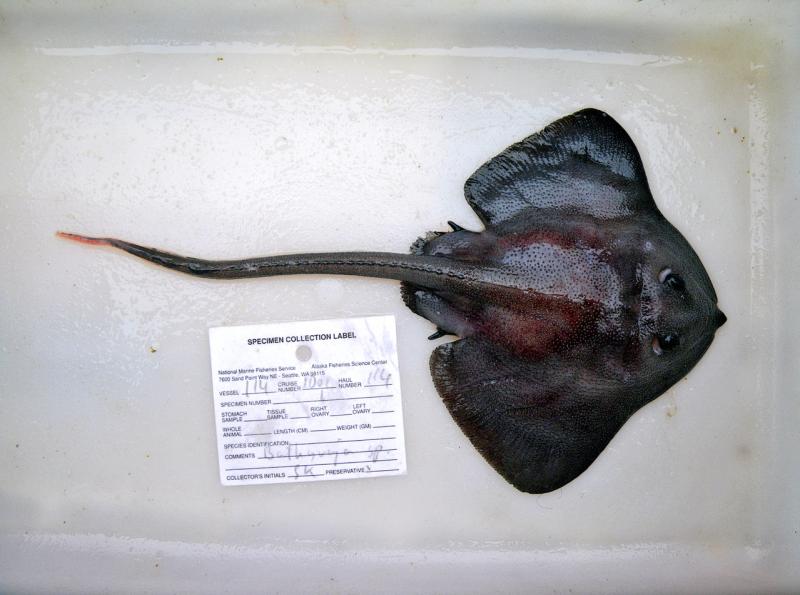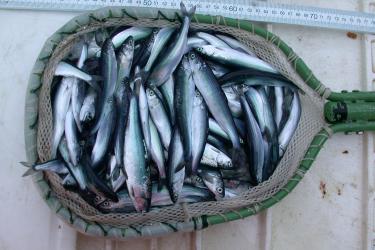![One of five Bathyraja microtrachys, the fine-spined skate, found at 1951 meter depth off British Columbia, Canada.]()
One of five Bathyraja microtrachys, the fine-spined skate, found at 1951 meter depth off British Columbia, Canada.
New Records Lead to New Discoveries
The team identified the juvenile male skate from the Bering Sea as a Pacific white skate.
“We compared our specimen with the first specimen that was used to describe the species, a juvenile from off Costa Rica that was almost the same size as ours. We were able to match the morphology (structural biology) of the juveniles closely,” said Orr. “It was the first record of the species for the Bering Sea and for Alaska.”
Since it was newly hatched, the juvenile Pacific white skate must have been spawned in the Bering Sea, rather than swimming there from somewhere else. The specimen is currently at the Burke Museum Fish Collection in Seattle.
This discovery led to another. The Royal British Columbia Museum had a large male skate in their collection that had been found off British Columbia. It had previously been identified as a different species.
“We made the connection. Ours was a juvenile, and the one from B.C. was a huge male. But when we looked at the morphology, they matched. Genetics confirmed it. It was an adult male Pacific white skate, and a new record for the species in British Columbia,” said Orr.
The five other skates collected off B.C. also set a new record there. They had initially been identified as the Okhotsk skate, a species previously known only from the western Pacific and western Aleutians.
“We were suspicious because they were collected far from the known range of Okhotsk skate and at a much greater depth—more than 1,000 meters deeper. When we finally saw them, we knew they were not the Okhotsk skate,” Orr said. “We worked up the complete morphology for all five specimens, and the Royal British Columbia Museum did the genetics. All five were fine-spined skates—and the first record of the species in British Columbia.”
Orr notes that their preference for great depths may explain why these two species have been so rarely encountered. “Their depth range lies outside the range of most surveys that sample near the seafloor. We typically tow to no more than 1,600 m; these are at 2,000-3,000 m. Even our deepest tows are just at the edge of their distribution.”
Skates in the Ecosystem
Skates are abundant, large, and ecologically important in the Bering Sea and North Pacific Ocean. Significant numbers of skates are caught as bycatch in fisheries targeting other species—enough to potentially affect skate populations.
Knowing what skate species there are and where they live is critical to understanding the ecosystem, and to effectively managing them.
Despite their similar morphology, not all skates are alike. Larger, longer-lived species, for example, could be overfished if not managed separately.
“In the 1990s identifying skates was a big problem. I contacted a world expert on skates, John McEachran from Texas A&M,” said Orr. “He came out to sea with us and developed a key for Aleutian Islands skates, which eventually led to the guide to all Alaska skates by Duane Stevenson, also a co-author on this project. Jerry Hoff had begun the slope survey and realized how abundant and diverse skates are in the Bering Sea. We discovered new species, the butterfly skate and leopard skate, with Ingrid working on genetics, which played a major role in identification.”
The program has continued work to better understand the role of skates in the ecosystem, their reproductive behavior, what nursery areas are important, and which populations need protection—and to make new discoveries.
Additional Resources
- Range Extensions and New Records from Alaska and British Columbia for Two Skates, Bathyraja Spinosissima and Bathyraja Microtrachys
- Fishes of the Salish Sea
- A field guide to sharks, skates, and ratfish of Alaska
- Stevenson, D. E., J. W. Orr, G. R. Hoff, and J. D. McEachran. 2008. Emerging patterns of species richness, diversity, density, and distribution in the skates (Rajidae) of Alaska. Fishery Bulletin 106(1):24-39.
- Stevenson, D. E., G. R. Hoff, J. W. Orr, I. Spies, and C. N. Rooper. 2018. Interactions between fisheries and early life stages of skates in nursery areas of the eastern Bering Sea. Fishery Bulletin 117:8–14.
- Orr, J. W., D. E. Stevenson, G. R. Hoff, I. Spies, and J. D. McEachran. 2011. Bathyraja panthera, a new species of skate (Rajidae: Arhynchobatinae) from the western Aleutian Islands, and resurrection of the subgenus Arctoraja Ishiyama. NOAA Professional Papers NMFS 11.
- Spies, I., D. E. Stevenson, J. W. Orr, and G. R. Hoff. 2011. Molecular systematics of the skate subgenus Arctoraja (Bathyraja: Rajidae): monophyly, cryptic speciation, and genetic support for a newly described species. Ichthyological Research 58:77-83.
- Spies, I. B., S. Gaichas, D. E. Stevenson, J. W. Orr, and M. F. Canino. 2006. DNA-based identification of Alaska skates (Amblyraja, Bathyraja and Raja: Rajidae) using cytochrome c oxidase subunit 1 (COI) variation. Journal of Fish Biology 69(Supplement B):283-292.
- Stevenson, D. E., J. W. Orr, G. R. Hoff, and J. D. McEachran. 2004. Bathyraja mariposa, a new species of skate (Rajidae: Arhynchobatinae) from the Aleutian Islands. Copeia 2004(2):305-314.





